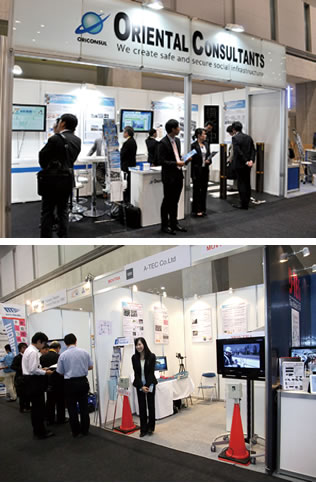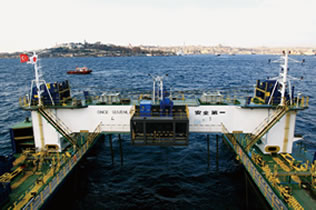- Home >
- Topics
Topics of No.8 (September, 2013)
Planning and operating a geothermal power plant and furthering the power generation business
ASANO TAISEIKISO ENGINEERING Co., Ltd., established a special-purpose company through a joint investment with eneforest Co., Ltd., a company that operates energy businesses, primarily in Oita Prefecture.
As a prime operator, ASANO TAISEIKISO ENGINEERING will handle all aspects of the geothermal power business, ranging from planning, engineering, construction, and operations to plant management.
The initial project underway is a 400-kilowatt geothermal facility in Oita Prefecture. Well drilling is set to start, with a view to electricity sales beginning in October 2015.
There are plans to operate plants with capacities of between 1,000 and 3,000 kilowatts.
As well as selling electricity, the company aims to help stimulate the local economy by fostering sectors in the area, such as greenhouse farming and terrestrial aquafarming, using recycled steam and hot water from power facilities and through investments and funding from these plants.
ACKG will leverage this expertise to cultivate similar businesses around Japan.
We plan to launch a micro hydroelectric power business by setting up regional special-purpose companies.
Note: Special-purpose companies are often created to run independently from parent companies in line with business operations.

Oita Prefecture has among Japan’s best geothermal resources, with many locations producing steam.

Centered on geothermal power generation, we can develop various businesses by recycling exhaust heat and hot water at multiple stages.
Exhibiting at the 20th ITS World Congress Tokyo 2013
ACKG exhibited in the 20th ITS World Congress Tokyo 2013 at Tokyo Big Sight in October 2013. Companies and organizations from around the world participated in the event.
Participants engaged with each other well beyond national, regional, organizational, corporate, and research boundaries. They introduced intelligent traffic systems technologies, products, systems, and services.
Oriental Consultants Co., Ltd., exhibited a pedestrian sensing and warning system, the Sherlock and Dr. Watson transportation safety support service, which employs a drive recorder, and a real-time traffic monitoring system.
We presented initiatives to contribute to enhance the safety and security of social infrastructure through intelligent traffic systems.
A-TEC Co., Ltd., presented the MOVTRA portable traffic counter and other devices and technologies to visitors from all over the world.
Note: The ITS World Congress is the only annual global gathering held jointly by the three world’s largest intelligent traffic system organizations. They are ERTICO of Europe, ITS America of the United States, and ITS Japan, which represents the Asia Pacific. The congress aims to resolve traffic issues and create business opportunities by promoting intelligent traffic systems.

The Oriental Consultants and A-TEC booths welcomed many visitors from around the world.
Using ICT-based inspection and diagnostic technologies to oversee the infrastructure maintenance and management business
For the past few years, ACKG has focused on maintenance and management for roads and other infrastructure. We have conducted R&D in infrastructure maintenance based on such information and communication technology tools as tablets and cloud computing.
An aging infrastructure has increased demand in Japan for effective and efficient infrastructural maintenance and management. To offer more comprehensive infrastructure maintenance services, we are collaborating with the town of Kamisato, Saitama Prefecture, in a road maintenance and management experiment.
Through this initiative, Kamisato is using ACKG’s road maintenance and management system for a limited period to verify the system from the road management perspective. Town officials are assessing the system by employing it in such services as support for routine patrols and regular inspections, remote diagnosis, and fault detection.
We are taking advantage of the experiment to explore ways to enhance road maintenance and management in the years ahead.
■ Routine patrol inspection support system

This system manages the recording of faults in paving, signage and lighting during routine road patrols or from resident reports and oversees measures taken for each fault. The system streamlines responses by efficiently automating tasks.
■ Remote diagnostic system

This setup remotely links site inspectors and diagnostic specialists and administrative officers to provide real-time visual and audio instructions. It enables accurate and immediate action once damage and deterioration are found during construction.
■ Abnormality detection system

This system analyzes videos from road camera to detect pavement abnormalities from rapid vehicle slowdowns or evasions, reporting abnormalities to road maintenance officials. The system operates automatically, eliminating the need for full-time personnel to monitor video cameras, accelerating responsiveness.
Fulfilling Turkey’s dream for the past 150 years of connecting Europe and Asia through a rail line beneath the Bosphorus Strait
Istanbul is Turkey’s biggest city, with around 14 million people. The city straddles Europe and Asia. The only way to cross the Bosphorus strait has been over two suspension bridges or by ferry. The area is vulnerable to nature’s whims, including thick fogs and snow. Improving transportation modes has always been an issue.
As a lead partner from Japan, from March 2002 Oriental Consultants collaborated with Turkish consultants in basic planning, tendering, and construction and management for a tunnel under the Bosphorus Strait and for upgrading commuter tracks located on both sides of the strait.
The railway was initially scheduled to open in 2009, but excavations of historic sites caused great delays. The crossing opened on October 29, 2013. Japanese Prime Minister Shinzo Abe was among those attending the opening ceremony, delivering a congratulatory speech.
Turkish engineers have dreamed of a railroad across the strait since 1860, when the Ottoman Empire ruled. With assistance from Japan, Turkey realized its dream after 150 years.

Submerging tunnel sections for a railway under the Bosphorus Strait

At a party to commemorate the opening of railway, Binali Yildirim, Turkey’s Minister of Transport, Maritime, and Communication, shook hands with Akihiko Hirotani, chairman of ACKG and Oriental Consultants.
Preparing an urban development master plan to develop Kumasi, Ghana’s second-largest city
Ghana is one of the leading democracies in West Africa. It has close ties with Japan and is well known as a producer of cacao, the key ingredient of chocolate.
Kumasi is the nation’s second-largest city, with a population of about 2.7 million. Kumasi is a vital transit point for goods entering countries inside the continent and as a central northern city.
The population has surged in recent years, resulting in inner city overcrowding, chaotic residential expansion in suburbs, and a lack of public services. There has been great anticipation for the urban development master plan that we created to healthily modernize Kumasi and contribute to economic progress.

Reducing human suffering by exploring evacuation shelter locations through evacuation simulations that matching local characteristics
Tsunami evacuation simulations are based on techniques for reproducing crowd evacuation behavior according to tsunami damage levels and evacuation progress.
Simulations draw on such data as evacuee residence locations, ages and family makeup, and evacuation shelter locations, evacuation means, and tsunami directions and speeds. Simulations make it possible to calculate the time needed for residents to reach shelters, making it possible to consider suitable locations for these facilities where evacuations are difficult.
This tsunami evacuation simulation model matches area characteristics, including built-up locations in which evacuees must cross major roads or swimming beaches where unspecified numbers of evacuees gather.
We configure simulation models with such objective data as population distributions and evacuee attributes based on statistics. We validate simulation conditions and methodologies through discussions with scholars.
■ Presenting evacuation simulation results as computer graphics animations

We show the results of evacuation behavioral simulation result as computer graphics animations combined with tsunami images. This allows residents in evacuation areas to better sense dangers, allowing local government officials to explain plans more effectively.

